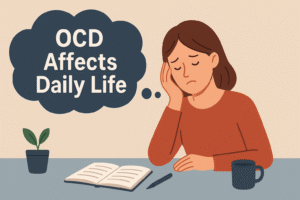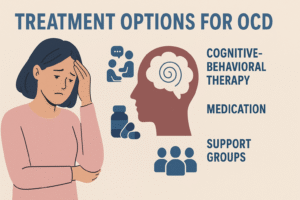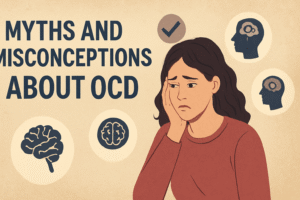Obsessive-Compulsive Disorder, more commonly known as OCD, is a mental health condition that affects millions of people worldwide. Despite its prevalence, OCD is often misunderstood and even misrepresented in popular culture. Many people assume it’s simply about being overly tidy or a perfectionist, but in reality, OCD is a complex condition that goes far beyond these stereotypes.
OCD can cause overwhelming distress, interfere with daily functioning, and take a significant toll on a person’s quality of life. However, the good news is that with proper understanding, support, and treatment, individuals with OCD can lead healthy and fulfilling lives. We’ll explore the causes, symptoms, and treatments of OCD in detail — while also shedding light on its impact on daily life and how to manage it effectively.
What is Obsessive-Compulsive Disorder (OCD)?
Obsessive-Compulsive Disorder is a mental health condition characterized by two key components: obsessions and compulsions.
Obsessions are unwanted, intrusive thoughts, images, or urges that trigger intense feelings of anxiety.
Compulsions are repetitive behaviors or mental acts performed to reduce the distress caused by obsessions.
For example, someone might experience the intrusive thought that their hands are contaminated with germs. To relieve the anxiety, they may engage in compulsive handwashing — not once or twice, but repeatedly, sometimes dozens of times a day.
It’s important to note that OCD isn’t a personality trait or a quirky habit. It’s a recognized mental disorder that can become debilitating if left untreated. People with OCD usually know their thoughts and behaviors are excessive or irrational, but they still feel compelled to carry them out, leading to a frustrating cycle.
Causes of OCD: Understanding the Root Factors
The exact cause of OCD is not fully understood, but researchers believe it develops from a combination of biological, genetic, environmental, and psychological influences.
1. Biological Causes
Studies suggest that abnormalities in brain structure and function may play a role in OCD. Specifically, overactivity in certain brain circuits — particularly those involved in regulating fear and behavior — may contribute to symptoms. Imbalances in the neurotransmitter serotonin have also been linked to OCD, which is why medications that affect serotonin levels are often prescribed as treatment.
2. Genetic Factors
OCD can run in families, which indicates that genetics may play a significant role. If a parent or sibling has OCD, there’s a higher chance of developing it. However, genetics alone don’t determine whether someone will have OCD; they only increase susceptibility.
3. Environmental Triggers
Stressful life events, trauma, or significant life changes (such as moving, starting a new job, or experiencing a loss) can trigger the onset of OCD in predisposed people. Infections such as streptococcal throat infections have also been linked to sudden-onset OCD in children, a condition sometimes referred to as PANDAS (Pediatric Autoimmune Neuropsychiatric Disorders Associated with Streptococcus).
4. Psychological Influences
Certain personality traits, such as a strong need for control, perfectionism, or sensitivity to uncertainty, may make a person more vulnerable to developing OCD. People who are naturally anxious or have difficulty coping with distress may also be more likely to experience OCD symptoms.
Common Symptoms of OCD
OCD symptoms can vary widely from person to person, but they typically fall into two categories: obsessions and compulsions.
1. Obsessions (Thoughts)
Obsessions are persistent, unwanted thoughts or urges that cause significant anxiety. Examples include:
Fear of contamination (e.g., germs, dirt, or chemicals).
Fear of harming oneself or others, even if there’s no desire to act on it.
Disturbing sexual or violent thoughts.
Intense fear of making mistakes or forgetting something important.
Needing things to be symmetrical, orderly, or “just right.”
2. Compulsions (Behaviors)
Compulsions are repetitive behaviors or mental acts performed to reduce anxiety caused by obsessions. Examples include:
Excessive handwashing or cleaning.
Repeated checking (e.g., doors, locks, appliances).
Counting, tapping, or repeating phrases to prevent harm.
Rearranging items until they feel “perfect.”
Mental rituals like silently praying or reviewing events.
Mayo Clinic – OCD Symptoms and Treatment
3. Emotional & Physical Impact
OCD is not just about thoughts and actions — it has an emotional and physical toll. People with OCD often feel exhausted from the constant anxiety and rituals. They may also feel guilt, shame, or embarrassment about their behaviors, which can lead to isolation.
4. Severity Levels
Some people may experience mild and manageable symptoms, while others face severe, disabling OCD that interferes with work, school, and relationships. Without treatment, symptoms often worsen over time.
How OCD Affects Daily Life
Living with OCD can be incredibly challenging. The condition can consume hours of a person’s day, leaving little time for work, school, hobbies, or relationships. For example, a simple task like leaving the house may take much longer if a person feels compelled to check locks, stoves, or lights repeatedly before leaving.
The emotional burden can also be heavy. Many people with OCD experience feelings of frustration, hopelessness, or shame. They may avoid social situations for fear of judgment or because their compulsions are too time-consuming. Unfortunately, stigma and misunderstanding often make things worse, as others may dismiss OCD behaviors as quirks or habits rather than recognizing them as symptoms of a mental disorder.

Diagnosing OCD: What to Expect
If you or someone you know suspects they might have OCD, the first step is to seek professional help from a psychiatrist, psychologist, or licensed therapist. Diagnosis usually involves:
Clinical Interviews: A professional will ask about symptoms, thought patterns, behaviors, and how they impact daily life.
DSM-5 Criteria: OCD is diagnosed based on established criteria in the Diagnostic and Statistical Manual of Mental Disorders.
Rule Out Other Disorders: Since symptoms of OCD can overlap with anxiety, depression, or ADHD, professionals work carefully to distinguish between them.
Early diagnosis is important because timely treatment can prevent symptoms from becoming more severe and disabling.
Treatment Options for OCD
The good news is that OCD is treatable. Although there’s no “cure” in the traditional sense, many people experience significant relief through therapy, medication, and lifestyle changes.
1. Cognitive Behavioral Therapy (CBT)
The most effective form of therapy for OCD is Cognitive Behavioral Therapy, specifically a technique called Exposure and Response Prevention (ERP). ERP helps people gradually face their fears (exposures) without engaging in compulsive behaviors (response prevention). Over time, this reduces anxiety and breaks the cycle of obsessions and compulsions.
2. Medication
Medications such as Selective Serotonin Reuptake Inhibitors (SSRIs) are commonly prescribed for OCD. These include fluoxetine (Prozac), sertraline (Zoloft), and fluvoxamine (Luvox). For severe cases, doctors may combine medications or try other antidepressants.
3. Lifestyle Changes
Simple lifestyle modifications can also support OCD management:
Regular exercise to reduce anxiety.
Good sleep hygiene to stabilize mood.
Mindfulness and meditation practices to help manage intrusive thoughts.
Stress management techniques like yoga or breathing exercises.
4. Alternative & Supportive Approaches
Some people benefit from joining support groups where they can connect with others who understand their struggles. Journaling, self-help books, and mobile apps designed for mental health can also provide additional coping tools.
5. Severe Cases
For individuals who don’t respond to therapy or medication, advanced treatments such as Transcranial Magnetic Stimulation (TMS) or Deep Brain Stimulation (DBS) may be considered. These are generally reserved for severe, treatment-resistant cases.

Living with OCD: Coping Strategies & Support
Managing OCD is an ongoing process, but with the right tools and support, it’s possible to live a fulfilling life. Some strategies include:
Practicing self-compassion instead of self-criticism.
Setting realistic goals for recovery.
Breaking compulsions into smaller steps rather than attempting to stop all at once.
Encouraging loved ones to learn about OCD so they can provide appropriate support.
Seeking professional help when symptoms interfere with daily functioning.
Support from family and friends is critical. Instead of enabling compulsions, loved ones can help by offering encouragement, patience, and empathy.
When to Seek Professional Help
If OCD symptoms are interfering with your work, school, relationships, or daily responsibilities, it’s time to reach out to a professional. Some signs that help is needed include:
Spending more than an hour each day on rituals.
Avoiding important tasks or social activities due to obsessions.
Feeling hopeless or overwhelmed by symptoms.
Remember, asking for help is not a weakness — it’s a sign of strength. Early treatment can make a tremendous difference.
Myths and Misconceptions About OCD
Despite increased awareness, OCD is still surrounded by myths that contribute to stigma. Let’s clear up some of the most common ones:
Myth 1: OCD is just about cleanliness.
Reality: While some people with OCD focus on cleanliness, others struggle with fears of harm, intrusive thoughts, or symmetry obsessions.
Myth 2: People with OCD can “just stop” their behaviors.
Reality: OCD is a neurological and psychological condition, not a choice. Compulsions are driven by intense anxiety that can’t simply be switched off.
Myth 3: OCD is rare.
Reality: Millions of people worldwide live with OCD. It’s estimated that about 1–2% of the global population is affected.
Dispelling these myths helps create a more compassionate understanding of what it truly means to live with OCD.

Conclusion
Obsessive-Compulsive Disorder is a serious but treatable condition. By understanding its causes, symptoms, and treatment options, we can reduce stigma, encourage early intervention, and support those living with OCD.
If you or someone you love struggles with OCD, know that help is available and recovery is possible. With therapy, medication, and self-care strategies, many people learn to manage their symptoms and live balanced, fulfilling lives.
Spreading awareness and compassion is key. The more we talk openly about OCD, the easier it becomes for people to seek the support they need without fear of judgment.
Frequently Asked Questions (FAQs)
Q1: Is OCD a lifelong condition?
Not always. For some, OCD symptoms improve significantly with treatment and may even go into remission. For others, it’s a lifelong condition that requires ongoing management.
Q2: Can OCD be cured naturally?
While natural approaches like mindfulness, exercise, and stress management can help, they are usually not enough on their own. Most people benefit most from a combination of therapy and, if needed, medication.
Q3: At what age does OCD usually start?
OCD often begins in childhood, adolescence, or early adulthood, though it can develop at any age. Early recognition and treatment are important.
Q4: Is OCD the same as perfectionism?
No. Perfectionism is a personality trait, while OCD is a diagnosable mental disorder involving intrusive thoughts and compulsions.
Q5: Can children have OCD?
Yes, children and teens can develop OCD. Recognizing the warning signs early and seeking professional help can greatly improve recovery and long-term management.

